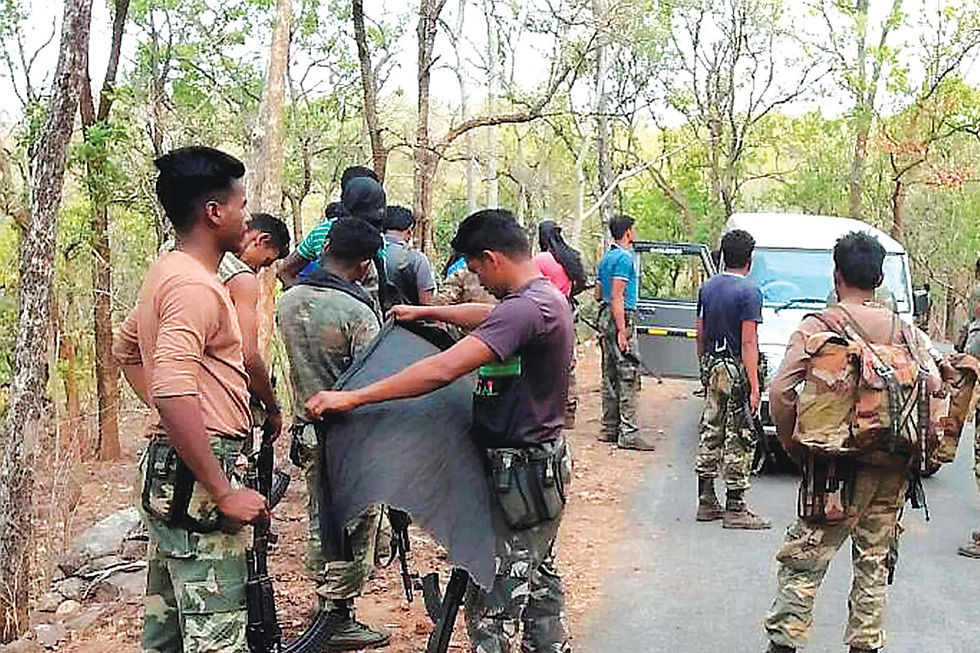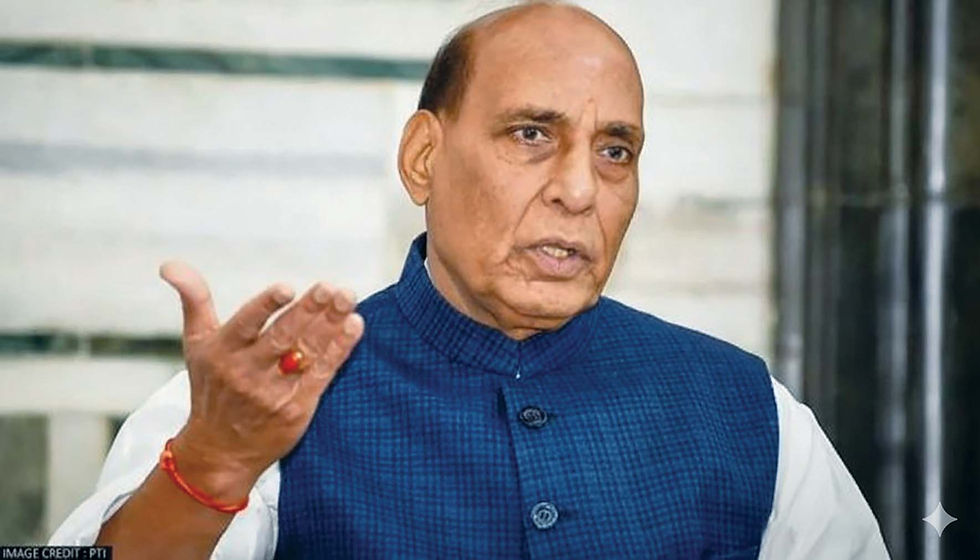The Maoist Echo in India’s Cities
- Uday K. Chakraborty

- Aug 12
- 5 min read
Maharashtra’s new ‘Urban Naxal’ law revives an old debate of how to fight insurgency without eroding dissent.

Maharashtra’s politicians rarely agree on anything, yet the state’s recently passed Special Public Security Act (SPSA) sailed through the legislature with barely a whimper from the opposition. Only the lone Communist Party of India (Marxist) legislator raised his voice against it. The law’s stated aim is to prevent “unlawful activities of Left-wing extremist organisations” and their sympathisers. Its detractors have dubbed it the ‘Urban Naxal Bill’ in a reference to a term popularised in recent years to describe those who, allegedly in air-conditioned comfort, aid Maoist guerrillas waging war in India’s forests.
Maharashtra thus joins four other states with similar statutes, seeking to plug what security agencies see as a dangerous gap in the country’s counter-insurgency armour. The gap is not in jungle combat but in the cities: those who run errands, provide shelter, courier messages, launder funds and manage the propaganda for Maoist groups. In theory, the bill targets only those who knowingly abet terrorism. In practice, critics fear it could criminalise legitimate political dissent.
Yet the bill’s easy passage also reflects a shared political memory. Successive governments, regardless of party, have battled the Maoist insurgency - an armed struggle that has outlasted the Cold War, multiple wars with Pakistan wars and even India’s post-liberalisation boom. In 2006, Manmohan Singh, a mild-mannered economist who happened to be prime minister, declared Maoist violence the country’s “single biggest internal security challenge”. It was a rare moment of agreement between Delhi and the chattering classes in Mumbai and Kolkata.
Naxalbari’s Shadow
Since the movement’s birth in 1967, when landless peasants in Naxalbari in northern West Bengal clashed with landlords and police, Maoist-inspired groups have operated across swathes of the country. At its peak in the late 2000s, roughly 160 of India’s 602 districts were classified as ‘seriously affected.’ More than 31,000 people including security personnel, guerrillas and civilians have died in the violence. Schools, roads and clinics in rebel strongholds have been blown up. Progress has been slowed, sometimes reversed, in districts that were poor to begin with.
The romance of revolution, the idea of guerrillas as pure-hearted radicals seeking to remake the world, has long been undermined by reality. Maoist leaders have done little to improve life in their ‘liberated’ zones beyond sporadically redistributing grain or holding ‘people’s courts’ that often end in summary executions. Armed struggle has become an end in itself.
Nor have they ever been entirely homegrown. From the start, India’s Maoists have had foreign patrons, ideological and practical. A curious, if unverified, anecdote from Pakistani general Jahangir Karamat’s memoirs recounts a conversation with Mao Zedong in which the Chinese leader urged weakening India from within, likening the tactic to entering the belly of a cow and tearing it apart from inside. Whether or not Mao ever spoke those words, Beijing’s fingerprints on the insurgency’s early years are clear.
The timing and geography of the Naxalbari uprising were suggestive. The district lies in India’s ‘Chicken’s Neck’ - the narrow Siliguri corridor connecting the northeast to the rest of the country, a few kilometres from Nepal and then-East Pakistan (now Bangladesh). In September 1967, mere months after the first clashes, five top Naxal leaders travelled via Nepal to Beijing, where they met Mao and received three months of training in guerrilla tactics. Chinese and Pakistani intelligence were active in the region. Arms were smuggled; East Pakistani ports became conduits for supplies. In the 1970s, more emissaries were dispatched to Beijing via circuitous routes through Europe and Albania.
For a while, West Bengal was the movement’s epicentre. In the 1970s and ’80s, Naxalite slogans hailed “China’s Chairman” as “our Chairman”. Urban students and unemployed youth flocked to the cause, often encouraged by sympathetic professors, journalists and artists. Bengali intellectual life, always quarrelsome, developed an eccentric alliance between Maoist revolutionaries and cultural figures who otherwise embraced Western liberal ideals. In the 1990s, one celebrated actress-director even visited a Maoist leader in his forest hideout, causing a commotion that let him slip past a police cordon.
When West Bengal’s security forces clamped down, many guerrillas moved to the forested heartland straddling Jharkhand, Odisha, Chhattisgarh, Andhra Pradesh and Maharashtra. There, the movement rebranded itself as a champion of tribal rights, exploiting grievances over displacement by mining projects and the state’s neglect. The jungles offered cover, the poverty a recruiting ground.
A younger crop of leaders rebuilt the Maoists’ networks. While the jungle squads laid ambushes, the cities supplied logistics, legal help, medical treatment, propaganda and cash. The urban network was hydra-headed: sympathetic lawyers and doctors, NGOs with human-rights mandates, activists with access to universities and the media. Some were witting participants; others, perhaps, were useful idiots. The police like to recall the case of a respected doctor who ferried messages between jailed leaders and comrades on the outside.
In the late 2000s, the ambitious, multi-state security campaign ‘Operation Green Hunt’ pushed the Maoists back. Many senior leaders were killed or captured. By 2023, the government claimed the number of ‘seriously affected’ districts had fallen to fewer than 50. But the insurgency has proved resilient. Leaders hide in deep forest. Cells lie dormant, awaiting revival. And the urban network, harder to detect and prosecute than an armed squad, remains a source of worry for intelligence agencies.
This is the context for Maharashtra’s SPSA. Its focus is not on jungle combat but on dismantling the urban support structure. That, security veterans argue, is the only way to ensure the Maoists cannot regroup. The law’s provisions allow the government to declare organisations unlawful, seize assets, and prosecute those who assist extremist groups. Similar laws in other states have not, so far, led to notorious abuses that have made headlines.
Still, the risk is real. In recent years, activists, journalists, and academics have been arrested under broad anti-terror laws such as the Unlawful Activities (Prevention) Act (UAPA), sometimes on evidence as flimsy as a computer file of dubious origin. The danger is that ‘Urban Naxal’ becomes as elastic a label as ‘anti-national’ or ‘terror sympathiser,’ capable of being stretched to fit a poet, a protester or a political opponent. Once a law is on the books, it is a matter of political will and political restraint how it is applied.
A state confident in its democracy must be able to distinguish between an armed conspiracy and a university seminar on Marxist thought. The two may overlap, but they are not the same. If the SPSA is wielded like a bludgeon against critics, it will do little to defeat the Maoists and much to corrode India’s constitutional freedoms.
India’s record offers both caution and encouragement. In states that have enacted similar laws like Chhattisgarh, Andhra Pradesh, Jharkhand and Telangana, there have been no sustained campaigns against mainstream political dissenters under their provisions. Effective counter-insurgency, when it has worked, has combined force with development and giving people a stake in the state’s success. Security sweeps alone do not drain the swamps in which insurgencies breed.
The Maoist movement’s history also suggests that its strength lies less in its ideology than in its ability to piggyback on real grievances like land disputes, tribal displacement and police brutality. Remove the grievances and the ideology withers. Leave them unaddressed, and new leaders will emerge to carry the old flag.
Maharashtra’s new law, then, is not a silver bullet. At best, it is one more tool in the kit. Used judiciously, it can help dismantle the clandestine networks that sustain insurgency. Used recklessly, it will alienate the very people the state needs to win over.
A half-century after Naxalbari, India knows that Maoist insurgency can be beaten back. Whether it can be beaten without also maiming dissent remains the unanswered question.
(The author is a veteran journalist based in Navi Mumbai. Views personal.)





Comments